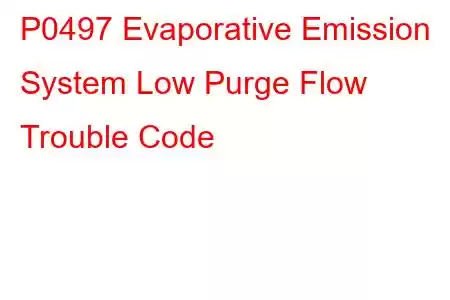P0497 Evaporative Emission System Low Purge Flow
OBD-II Trouble Code Technical Description
Evaporative Emission System Low Purge Flow
What does that mean?
This diagnostic trouble code (DTC) is a generic powertrain code, which means that it applies to all 1996-newer vehicles (Ford, Honda, Mazda, Mercedes, VW, etc.). Although generic, the specific repair steps may vary depending on make/model.
When I see that a code P0497 has been stored, I know that the powertrain control module (PCM) has detected a low flow condition in the evaporative emissions (EVAP) purge system.
Designed to capture fuel vapors (from the fuel tank) before they escape into the atmosphere, the EVAP system utilizes a closed reservoir to store excessive vapors until the engine is prepared to burn them. Fuel vapors are routed to the reservoir (usually called a canister), through a specially designed valve and network of metal tubes and rubber hoses. The pressure that is built when fuel is stored causes the vapors to vent into the tubes and eventually the canister. The canister contains a charcoal element that absorbs fuel vapors for release at the appropriate time.
The purge control solenoid is activated when the PCM deems that the engine is in a state to burn the EVAP fuel vapors efficiently. An EVAP pressure sensor is used to monitor EVAP system efficiency.
The P0497 code is related to the EVAP purge valve. The purge control solenoid/valve is usually located in the engine bay. A constant intake vacuum supply hose (from the engine intake manifold) is attached to one opening of the purge control valve with a second line attached to the only other opening. In most cases, a constant supply of battery voltage is present at one terminal of the purge control valve and the PCM provides a ground pulse when drivability conditions are optimal. This allows the valve to open and intake vacuum to reach the canister. When vacuum reaches the canister, ambient air is drawn through the charcoal element and it releases the fuel vapors that have been store therein. Engine vacuum draws the fuel vapors into the intake manifold where they are burnt alongside conventional fuel.
In some systems, if there is not sufficient change in manifold air pressure or exhaust oxygen content, when the purge control solenoid/valve is opened, a P0497 will be stored and a service engine soon lamp may be illuminated. Other systems utilize an EVAP pressure sensor to monitor and control purge and vent control solenoid operation. In this type of system, if EVAP pressure fails to drop sufficiently when the purge control valve is opened, a code will be stored and service engine soon lamp illumination may occur.
Symptoms & Severity
This is an emissions related code. While it may slightly reduce fuel efficiency, there is no inherent danger involved. Symptoms of a P0497 code may include:
Slightly diminished fuel efficiency The sound of a vacuum leak from the underhood area Poor engine idle quality In most cases, no symptoms will be exhibitedCauses
Potential causes for this code to set are:
Defective EVAP pressure sensor Faulty EVAP purge solenoid/valve Restricted EVAP canister element Shorted or open circuit (wiring or connector) for the EVAP purge control solenoid/valve Cracked, crimped, or collapsed vacuum lines/hosesDiagnostic and Repair Procedures
A good starting point is always to check for technical service bulletins (TSB) for your particular vehicle. Your issue may be a known issue with a known fix put out by the manufacturer and can save you time and money during diagnosis.
A suitable diagnostic scanner, a digital volt/ohmmeter, a manufacturer’s service manual (or equivalent), and a smoke machine will help to diagnose code P0497.
I have a habit of beginning my diagnosis with a visual inspection of all system wiring and conn
Read: 45


